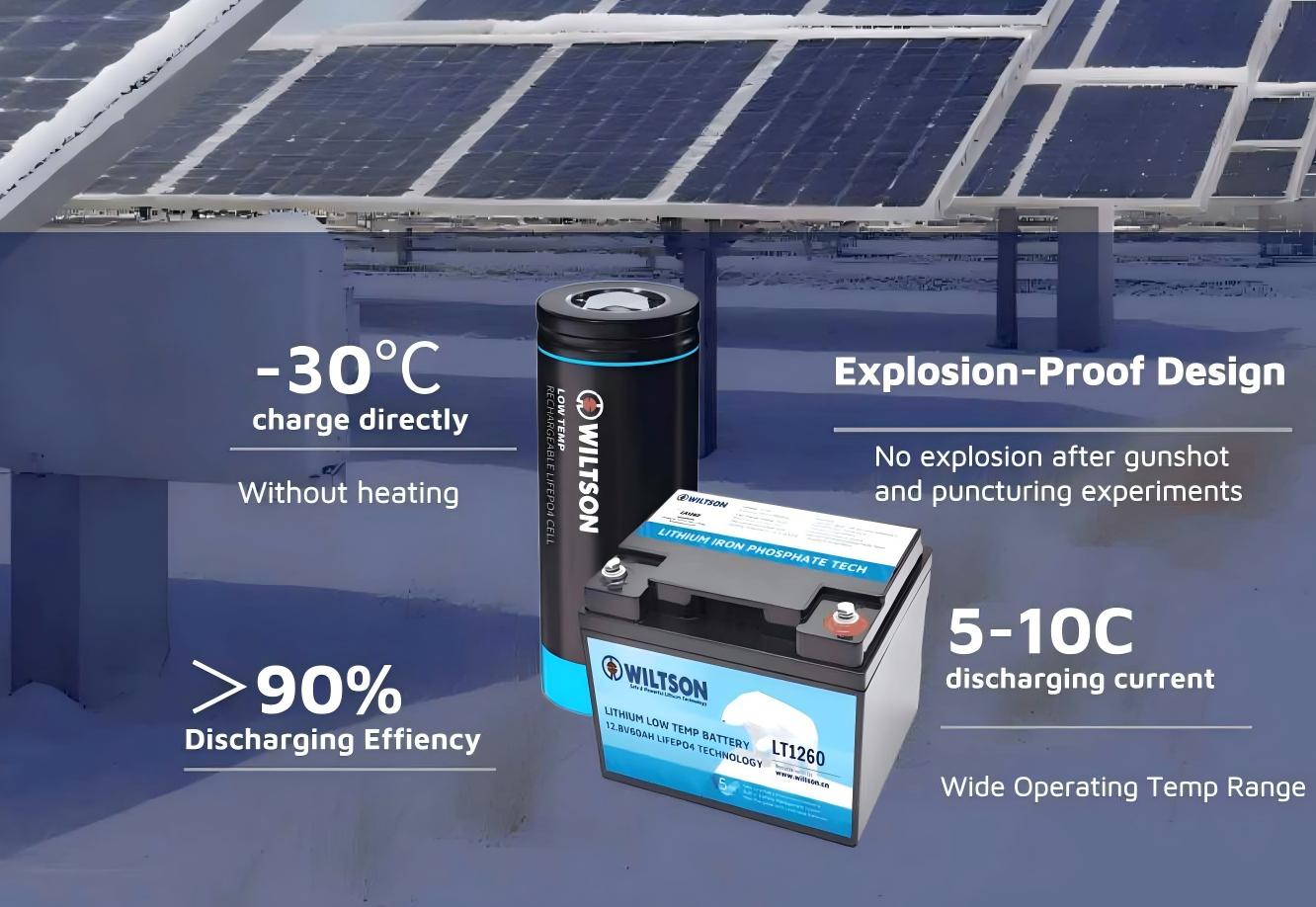The Role and Value of Low-Temperature Batteries in Solar Tracker Systems

Introduction
In recent years, the global solar industry has been accelerating toward higher efficiency. Solar tracker systems, which adjust photovoltaic (PV) modules in real time, can increase energy yields by 10%–40% compared to fixed installations. This technology has been widely adopted in utility-scale and commercial solar plants across North America and Europe. However, in cold climates, trackers face a critical bottleneck: traditional lead-acid batteries lose 20%–30% of their capacity below $0^\circ\text{C}$, and standard lithium batteries suffer efficiency loss or dendrite growth risks during low-temperature charging. As a result, trackers may stall in winter, undermining their designed generation advantage.
To address this challenge, the industry has turned to specialized low-temperature battery solutions. In recent years, manufacturers have released LiFePO₄ battery systems capable of direct charge and discharge operations at extreme cold conditions, even down to $-40^\circ\text{C}$. These solutions are unlocking new opportunities for solar deployment in northern regions.
Technology and Applications
Core Technical Features
The Wiltson Energy 26650 LiFePO₄ low-temperature cell demonstrates the critical design innovations: it can be charged at $-30^\circ\text{C}$ without auxiliary heating, features explosion-proof and overcharge protection, and maintains high discharge efficiency at $-40^\circ\text{C}$. According to product specifications, the cell retains over 90% of its rated capacity at $-40^\circ\text{C}$ and supports discharge rates up to $5\text{C}$.
- Wide Temperature Range: Supports stable operation from $-40^\circ\text{C}$ to $+60^\circ\text{C}$, with direct low-temperature charging, eliminating the need for external heaters.
- High-Rate Performance: Delivers 90%+ capacity even at $-40^\circ\text{C}$ with discharge rates up to $5\text{C}$, ensuring sufficient current for tracker actuators.
- Safety and Reliability: Based on LiFePO₄ chemistry with high intrinsic thermal stability; equipped with short-circuit protection, overcharge safeguards, and military-grade puncture testing to ensure safe operation in extreme environments.
- Modular Design: The standardized 26650 cylindrical format allows flexible system scaling, supporting both string and parallel expansion for large-scale deployment.
- Fast UPS Switching: Can serve as an uninterruptible power supply (UPS), switching within 10 milliseconds during grid faults to ensure tracker continuity during blizzards, polar nights, or outages.
Application Scenarios
- Utility-Scale Solar Farms: In northern Europe, Canada, and northern U.S. regions, low-temperature batteries sustain tracker functionality during harsh winters, maintaining year-round high performance.
- Commercial & Industrial Solar: C&I PV plants and agrovoltaic projects use low-temperature storage to mitigate downtime during seasonal cold spells. Modular battery packs provide flexible scaling for diverse system sizes.
- Off-Grid and Remote Microgrids: In remote ranches, mountainous terrain, or island communities, trackers rely on cold-resistant batteries for continuous operation during snowstorms or grid disruptions.
- Critical Infrastructure Loads: Telecom towers, weather stations, and other mission-critical sites can utilize these batteries for powering trackers or direct DC loads under severe cold.
Advantages Analysis
- Performance & Reliability: Compared with lead-acid or standard lithium batteries, low-temperature LiFePO₄ demonstrates clear superiority. Wiltson Energy’s testing shows 90%+ capacity retention at $-40^\circ\text{C}$, whereas lead-acid suffers severe derating and conventional lithium cells require pre-heating. This ensures trackers continue to deliver their 10%–40% yield advantage even in winter.
- Cost & Efficiency: Although the upfront unit price is higher than lead-acid, total cost of ownership is lower due to the elimination of heaters, reduced maintenance, and longer service life. LiFePO₄ achieves $>95\%$ round-trip efficiency and $>3,000$ cycles, lowering LCOE compared to legacy solutions.
- Safety & Environmental Impact: LiFePO₄’s crystal structure provides thermal stability, reducing thermal runaway risks. Wiltson’s cells include explosion-proof construction and passed stringent abuse testing. Environmentally, LiFePO₄ contains no heavy metals and is highly recyclable, while lead-acid poses contamination risks.
- Sustainability: Extended lifecycle, low self-discharge, and recyclable materials reduce waste streams and carbon footprint, aligning with clean energy goals.
Challenges and Considerations
- Cost and ROI: Despite long-term savings, upfront costs remain higher than conventional solutions. Developers must weigh increased yield and system reliability against CAPEX. Economies of scale and policy incentives will help narrow the gap.
- Integration & Compatibility: Low-temperature cells require optimized battery management systems (BMS) and careful thermal design. Tracker OEMs must ensure compatibility with control electronics and mechanical systems. Cable insulation and structural materials must also be specified for extreme cold.
- Regulatory Compliance: Certification such as UN38.3, IEC, and UL is required for transport and deployment. Companies must also comply with EU Battery Directive and establish recycling pathways.
- Operations & Maintenance: Remote sites increase O&M costs. Remote monitoring, predictive analytics, and state-of-health (SoH) diagnostics are essential to ensure timely servicing and lifecycle management.
Case Study: Wiltson Energy
Wiltson Energy has specialized in LiFePO₄ storage solutions for extreme environments. In 2025, Wiltson introduced its 26650-format low-temperature backup battery for solar tracker systems. The solution enables direct charge/discharge at $-40^\circ\text{C}$ without external heaters, retaining ~90% of capacity while supporting $5\text{C}$ discharge for high current demands.
The system doubles as a UPS, switching within 10 ms during grid loss, ensuring tracker availability during storms or polar nights. Wiltson’s design enables solar projects in the Arctic Circle, northern Canada, and Scandinavia to operate reliably year-round, delivering measurable improvements in yield and lowering O&M risk.
Future Outlook
As global clean energy demand accelerates, especially in Europe and North America, low-temperature battery technologies are becoming increasingly strategic. Market forecasts suggest solar tracker adoption will grow at a CAGR above 26% through 2034. Batteries like Wiltson’s are critical enablers, ensuring consistent performance in cold climates.
With their safety, reliability, and sustainability credentials, LiFePO₄ low-temperature batteries will play a vital role in strengthening grid resilience, supporting renewable integration, and maximizing solar output across diverse geographies.
Wiltson Energy states: “This innovation is not just an upgrade—it is the key to making solar tracking reliable in any climate, ensuring customers can maximize their energy yield year-round.”
Partner with Wiltson Energy to deploy next-generation low-temperature battery solutions for your solar tracker projects. Enhance efficiency, reliability, and sustainability—no matter how cold the climate.

